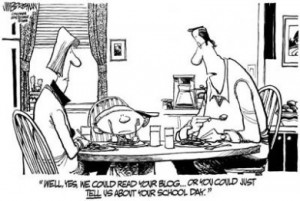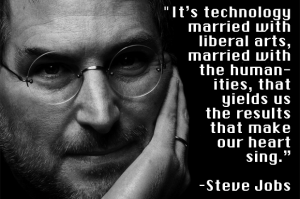“Multimedia and the internet enable learners to find a voice for themselves at the intersection of multiple time scales, to represent their own version of reality through multimodal texts, and to confront a broad public audience with that reality.”
(Kramsch, 98)
Technological Literacy Changes: Communication, Learning and Teaching
In the digital era, the way in which we communicate and learn has flourished and evolved. We are witnessing new devices and “cyber communities” in the social networks that allow interface users to communicate and share information from any part of the world. As a consequence of this process, digital media has acquired an important role in today`s society since it is socially expected to have technological literacy. The International Technology and Engineering Educators Association (ITEEA) defines technological literacy as “one’s ability to use, manage, evaluate, and understand technology”. This technological literacy implies the ability to communicate, access, manage, evaluate and share information, and to write for targeted audiences. In this context, digital writing has become a key element to enhance technological literacy in today`s world, which has changed the way we manage, learn, and teach technological skills.
Before delving into the changes triggered by digital environments, it is important to define what are digital environments or social networks.
Social networks
In their journal article, Social Network Sites: Definition, History, and Scholarship, Danah Boyd and Nicole Ellison define social networks as “web-based services that allow individuals to construct a public or semi-public profile within a bounded system, articulate a list of other users with whom they share a connection, and view and traverse their list of connections and those made by others within the system. The nature and nomenclature of these connections may vary from site to site” (211).
Digital environments and audience
Digital environments pose a challenge to students and teachers on how to manage technological tools, while thinking critically about the targeted audience. In her book, Made Not Only in Words: Composition in a New Key, Kathleen Blake Yancey explains that technology contributed to the creation of a “writing public genre” that is interconnected with technology. Kathleen defines literacy as a “tectonic change”, where writing correctly is not only restricted to grammar, usage and composing. Instead, literacy is linked to words, images, audio files, videos, instant messaging, word processors, and Web logs. Society of the 21st century, and more specifically, teenagers and adults, are part of a “writing public made plural” that is occurring outside the classrooms (300-303). These writers, who take part in online communities without any borders, construct cooperative and collaborative learning in the digital environment by themselves:
Yancey points out that “the members of the newly developed reading public have learned to write, to think together, to organize, and to act within these forums- largely without instruction […] They need neither self-assessment nor our assessment: they have a rhetorical situation, a purpose, a potentially worldwide audience, a choice of technology and medium- and they write.” (301- 302).
Yancey`s words imply that students have an online space of their own: not all of them make accurate use of social media. Students have a space within their own communities in the social media like Facebook or Twitter and they write, share knowledge, and learn with their public audiences. Given these media, in which public and private communication occur, the author suggests that teachers should teach composition through three approaches to media where writing has individual and cultural meaning: circulation of texts, genre, and media. For instance, she suggests that when teaching digital environments like blogs or portfolios, students carefully select the media and the information they want to share with their community. As a result of teaching how to write publicly, teachers foster rhetoric, composition, communication, and social justice and the ability to write for broader audiences.
Digital environments and education
Digital environments also enhance a plethora of benefits for students, and thus, they change the way education is imparted. The exposure to multimodal literacy changes the way students respond to the instructions. A recently published journal article, Using Digital Story Projects to Help Students Improve in Reading and Writing by Hani Morgan, explains in detail how the use of digital story helps students improve reading and writing. Morgan argues that digital stories promote learning, engage students, and help them create coherent content, increase meaning of their work, and improve the students’ self- confidence. This argument is further developed in the research: Developing Writing Abilities of EFL Students through Blogging by Orachorn Kitchakarn. In the scholarly article, it shows how blogging brought positive outcomes for students who worked on Web logs:
The results show that “the students’ writing abilities significantly improved. The positive effect of using blogs in writing development was possibly due to the features of blogs that students can communicate with other audiences in authentic learning environment” (Noytim, 2010, Juida & Bee, 2011). Blogs have potential to support L2 teachers’ teaching and students’ learning in classroom and make students increase their engagement (Churchill, 2009). […]Students learn and share with their peers and teacher during the working process. Surprisingly, students who are low proficient learners or shy and quiet ones have more participation in doing tasks by using blogs (43).
Not surprisingly, blogging then, enables better ESL student’s learning process: it engages students, improves their writing skills, and better connects them with the audience.
Digital environments and learning
Together with digital media, technology has become part of our process of thinking. According to Marc Prensky, in the 21st century, technology is not about new devices, but rather “an extension of our brains, it`s a new way of thinking”. Technology provides people with the abilities they need in all domains. It is part of an external cognitive process “closer to symbiosis” (23-26). It then, allows people to be more efficient once they learn how to manage themselves in a correct manner. This new way of thinking should be accompanied by a change in the K-12 curriculum as is suggested in the article, Effective Thinking, Effective Action, and Effective Relationships. Prensky believes that,
“Effective Thinking, which would include creative and critical thinking as well as portions of math, science, logic, persuasion, and even story telling; Effective Action, which would include entrepreneurship, goal setting, planning, persistence, project management, and feedback; and Effective Relationships, which would include emotional intelligence, teamwork, ethics, and more. ” (Prensky, 26)
Digital writing in college life
Writing digitally has changed the way in which students display and share information in a public domain, the way they learn, and the way teachers approach pedagogical methods. Being “digital natives”, or being born in the digital age (Prensky, 117), does not imply that we, as learners, have technological literacy. And, the path to foster technological literacy is to enhance writing for digital environments.
Digital Environments and Audience
Like in any other traditional writing, the writer must always consider the intended audience. My audience for example, could be my friends or family and I would make assumptions about their background or knowledge. However, there is an extra element to consider that I am not fully conscious of: unanticipated audiences. Since digital environments are commonly shared spaces with unknown people, there might be other people interested on the topics we write about and it is important to consider writing for broader audiences.
My thoughts on digital environments
From a personal perspective, digital environments do engage my writing. In my career–oriented school, many times I felt frustrated and I was reluctant to write essays. Unlike my old school, at Dickinson College I would say I love writing my blog, and I feel truly motivated. I used to write only literary essays about novels and short stories, which, after three years, became boring and monotonous. I do not consider the activity of blogging as a task, but as a liberating endeavor where I can write about what I am passionate about, a space where I can find my voice.
Regarding collaborative and cooperative learning, I have to admit that I used to believe peer review would not help me much; however, the experience of peer reviewing made me change my mind. Firstly, after listening to other peers’ opinions and comments on the papers assigned in classes, I have heard many enlightening comments and quotes from the lectures. Secondly, sharing my blog proposal with my classmates helped me to improve my project in aspects that I have not thought of before, and I hope my comments have helped them as well. My classmates’ opinions made me see my proposal from other perspectives and they broadened my possibilities. Finally, reading a comment about my blog post was a positive boost to my self-esteem. Since English is my second language, I generally do not like my writing style and I do not feel completely comfortable; however, a compliment made my day.
Works cited
Boyd, D. M., & Ellison, N. B. “Social network sites: Definition, history, and scholarship.” Journal of Computer-Mediated Communication 13.1 (2007): 210-211. Dickinson Wiley Online Library. Web. 25 Oct. 2014.
Kitchakarn, Orachorn. “Using Blogs to Improve Student’s Summary Writing Abilities.” Turkish Online Journal of Distance Education-TOJDE 13.4 (2012): 209–219. Dickinson Wiley Online Library. Web. 25 Oct. 2014.
Kramsch, Claire, Francine A’Ness, and Wan Shun Eva Lam. “Authenticity and Authorship in the Computer-mediated Acquisition of L2 Literacy.” Language Learning and Technology. Oxford: 2nd ed., (2000): 78-104. Web.
Morgan, Hani. “Using digital story projects to help students improve in reading and writing.” The University of Southern Missisippi: 51.1(2014): 20-26. Dickinson Wiley Online Library. Web. 23 Oct. 2014.
Prensky, Marc. “Teaching Digital Natives.” Marc Prensky (2005): 117-120. Web.
Prensky, Marc. “Our Brains Extended.” Educational Leadership (2013): 23- 30. Web.
“Technologically Literate Citizens.” IteaConnect. 1 Jan 2011. Web. 20 Oct. 2014. http://www.iteaconnect.org/TAA/TAA_Literacy.html
Yancey, Kathleen.”Made Not Only in Words: Composition in a New Key. ” Colllege Composition and Commnication 2.1 (2004): 297- 328. Web.


